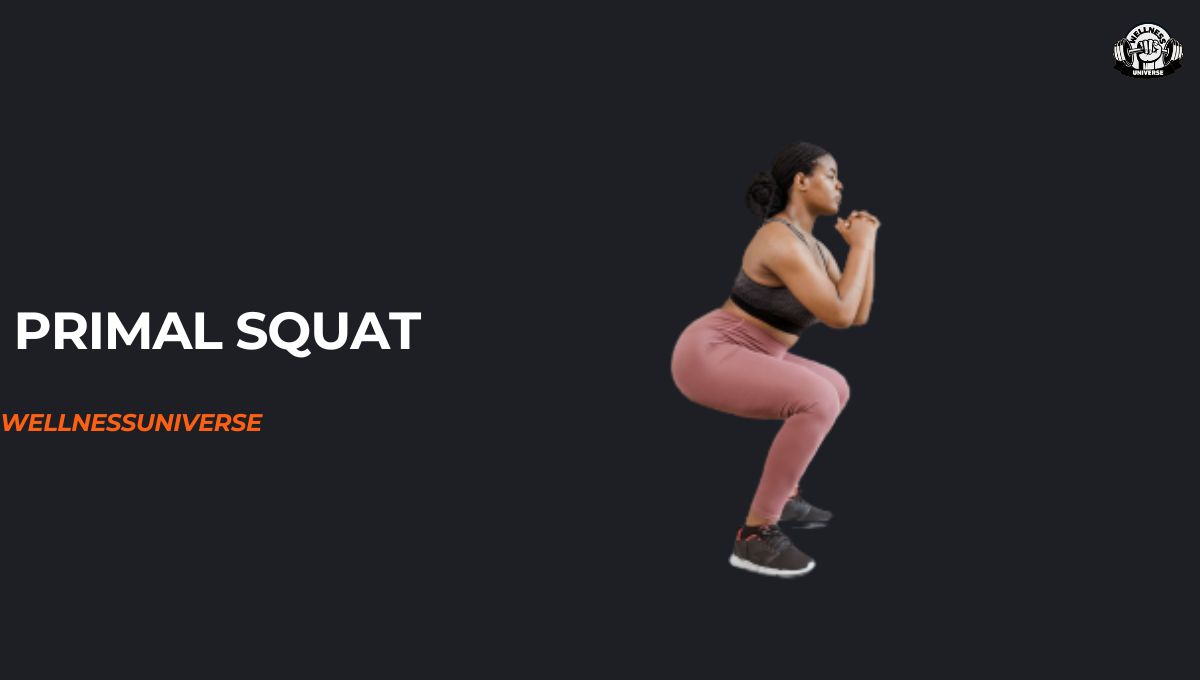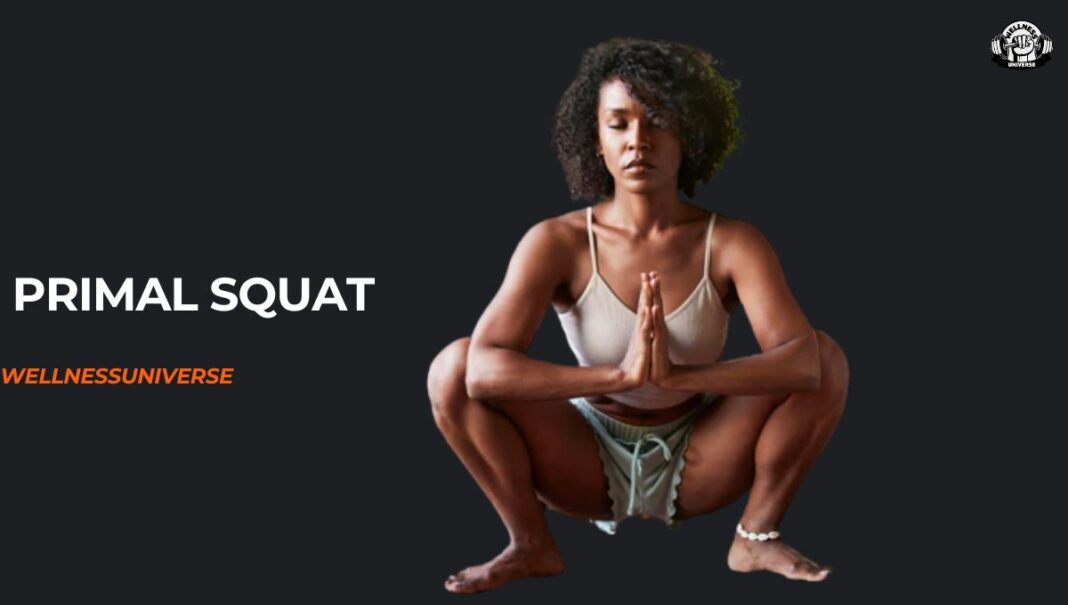Welcome to the world of primal movement and the primal squat—a dynamic exercise that taps into your body’s natural range of motion. The primal squat, often referred to as the “grok squat,” is a versatile movement pattern that mimics the way our ancestors would sit and move, promoting functional strength, flexibility, and mobility.
In today’s modern world, we often find ourselves sitting for extended periods, leading to decreased mobility and flexibility. Primal movements, like the primal squat, offer a remedy by reconnecting us with fundamental patterns of human motion. By integrating these movements into our fitness routines, we can enhance our ability to move effortlessly, prevent injuries, and improve our overall quality of life.
Throughout this blog, we’ll delve deep into the realm of primal squats. From understanding the technique and its benefits to exploring variations that can challenge your strength and mobility, we’ve got it all covered. Whether you’re a beginner or an experienced fitness enthusiast, this comprehensive guide will equip you with the knowledge you need to master the primal squat and unlock its full potential. So, let’s begin our journey towards improved movement and vitality.
Understanding the Primal Squat Technique

The primal squat is a fundamental movement pattern that mimics how our ancestors would rest and move naturally. Unlike traditional squats, where the focus is often on heavy weights, the primal squat emphasizes functional movement and mobility. To perform a primal squat, start by standing with your feet shoulder-width apart and your toes slightly turned out. As you descend, your hips will move back, and your knees will bend, allowing you to lower yourself into a deep squat position. The key here is to keep your heels grounded, maintain a neutral spine, and allow your hips to open.
What sets the primal squat apart from traditional squats is its focus on full-range mobility and flexibility. Traditional squats often involve external resistance, such as weights, which can limit your range of motion. In contrast, the primal squat relies solely on your body weight and natural movement, promoting better hip and ankle mobility. This movement can improve joint health, prevent muscle imbalances, and enhance overall functional fitness.
Executing a proper primal squat requires attention to detail. Start by maintaining an upright torso and keeping your chest up as you descend. Your weight should be evenly distributed between your heels and the balls of your feet, with your knees tracking over your toes. Engage your core muscles to support your spine and keep your back neutral. Allow your hips to lower as deeply as your mobility allows, aiming to achieve a comfortable position where your thighs are parallel to the ground or lower. Remember, the key is to prioritize mobility over depth, so find the range that feels right for your body.
Muscle Engagement and Functional Benefits
Engaging multiple muscle groups, the primal squat provides a comprehensive lower body workout. As you descend into the squat, your quadriceps play a significant role in extending your knees. Simultaneously, your hamstrings assist in flexing your hips and knees, and your glutes aid in hip extension. Your core muscles are also activated to stabilize your spine and maintain balance throughout the movement. This holistic muscle engagement leads to improved lower body strength and functional fitness.
Hip mobility is crucial for maintaining a full range of motion in various activities and preventing discomfort. Primal squats are particularly effective in improving hip mobility because they require your hips to move through a wide range of motion. By consistently practicing primal squats, you can gradually increase the flexibility of your hip joints and improve the fluidity of your movements. Enhanced hip mobility can positively impact daily activities like walking, running, and bending, allowing you to move more freely and comfortably.
Primal Squats for All Fitness Levels
Primal squats are incredibly versatile and can be adapted to accommodate individuals of all fitness levels. Whether you’re a beginner looking to enhance your movement patterns or an experienced athlete aiming to diversify your workout routine, primal squats offer benefits for everyone. Their fundamental nature mimics natural human movement, making them accessible even to those new to fitness. As you progress, you can gradually increase the intensity and complexity of the movements, ensuring that primal squats remain a valuable addition to your fitness regimen.
For those seeking an extra challenge, various primal squat variations can be incorporated to elevate the intensity of your workout. Weighted primal squats involve holding dumbbells, kettlebells, or other forms of resistance to increase the load on your muscles. This can lead to greater strength gains and muscle development. Additionally, lateral movements, where you step sideways while performing primal squats, engage different muscles and enhance lateral stability. These variations provide options to keep your workouts engaging and to continue progressing in your fitness journey.
Injury Prevention and Joint Health
One of the remarkable benefits of practicing primal squats is their inherent focus on proper movement mechanics and balance. By engaging in these natural and functional movements, you’re enhancing your body’s ability to move in a coordinated manner, which in turn reduces the risk of injuries. Primal squats emphasize correct alignment and posture, fostering muscle activation that supports joints and ligaments. This can help prevent strains, sprains, and other common injuries that may arise from poor movement patterns or imbalances.
Primal squats play a pivotal role in maintaining and enhancing joint health, particularly in the knees and hips. These movements encourage a full range of motion in these joints, promoting joint fluidity and flexibility. As you perform primal squats regularly, your body adapts to the functional movement patterns, which can lead to improved joint mobility over time. This is particularly beneficial for individuals with sedentary lifestyles or those who have experienced joint stiffness. By incorporating primal squats into your routine, you’re actively contributing to the health and longevity of your joints.
In Crux
Incorporating primal squats into your fitness routine can truly unlock a realm of benefits that extend beyond traditional exercises. By engaging in these movements that mimic natural human patterns, you’re tapping into a wellspring of functional strength, mobility, and overall well-being. The primal squat serves as a bridge between modern fitness and the movements that our bodies were designed to perform.
As we conclude this journey into the realm of primal squats, it’s important to remember that our bodies are designed for movement. Embracing the essence of natural movement can significantly enrich your physical health and quality of life. So, whether you’re a fitness enthusiast looking to diversify your routine or someone seeking a way to enhance mobility, the primal squat offers a path toward a more functional and empowered you. Start incorporating this primal movement into your fitness regimen, and let the benefits radiate through your strength, mobility, and vitality. Your body will thank you for embracing the power of primal strength.
Thank you for joining us on this fitness journey! We hope you found our Unleash Your Inner Strength: The Primal Squat Guide? blog insightful and inspiring. Our aim is to provide you with valuable information, expert advice, and motivational content to support you in your wellness endeavors.
Related Post :-
- How To Do Wall Pushups
- Hand Size Demystified
- CrossFit Unleashed
- Barbell Lunges
- Forearm Fortitude
- Kettlebell Circuit
- Power of Personal Trainers
- Down Pull-Ups
FAQs about Primal Squat
What are the benefits of incorporating primal squats into my workout routine?
Primal squats offer a range of benefits, including improved hip mobility, enhanced lower body strength, increased flexibility, and better posture. These movements engage various muscle groups and promote a more functional range of motion, which can translate to better everyday movements and reduced risk of injury.
How does a primal squat differ from a traditional squat?
While both primal squats and traditional squats target the lower body, primal squats prioritize natural movement patterns. Primal squats often involve a wider stance and a deeper squat, which engages different muscle groups and encourages greater hip mobility. Traditional squats may focus more on gym-based exercises with standard squatting techniques.
Are primal squats suitable for all fitness levels?
Yes, primal squats can be adapted to different fitness levels. Beginners can start with shallower squats and gradually work on improving their depth and mobility. For advanced individuals, adding weight or variations like lateral movements can intensify the workout.
What muscles are targeted during a primal squat?
Primal squats primarily target the quadriceps, hamstrings, glutes, and core muscles. The wider stance and deeper squat engage these muscle groups in a unique way, promoting balanced lower body strength and stability.
Can primal squats help improve hip mobility and flexibility?
Absolutely. Primal squats involve a deep squatting motion that helps improve hip mobility and flexibility. By engaging the hip joints through their full range of motion, you can experience increased flexibility and more fluid movement.
Are there variations of primal squats for an added challenge?
Yes, there are variations to add complexity and challenge to primal squats. Weighted primal squats, where you hold a weight close to your chest, can increase resistance. Lateral movements, where you step to the side while squatting, can also intensify the workout.
What is the correct form and technique for performing a primal squat?
Start by standing with your feet wider than shoulder-width apart and your toes slightly turned out. Lower your body into a deep squat, keeping your chest up, back straight, and heels on the ground. Engage your core and push through your heels to return to the starting position. Focus on maintaining proper alignment and controlled motion throughout.
How often should I include primal squats in my training program?
The frequency of primal squats depends on your fitness goals and overall routine. You can start with 2-3 sets of 10-15 reps and gradually increase as you become more comfortable with the movement. Listen to your body and adjust the frequency based on your recovery and progress.
Can primal squats be used for functional fitness and everyday movement?
Absolutely, primal squats are rooted in natural human movement patterns, making them highly functional for everyday activities. They enhance your ability to move in different planes and improve your overall lower body strength and mobility, which can benefit your daily life movements and activities.

Meet Pradeep Singh, your go-to guide for all things fitness, health, and motivation. With over 7 years in the field, Pradeep brings a blend of expertise and real-world experience to his writing. From workout tips to healthy living insights, he simplifies complex topics, making fitness accessible for everyone. His authentic approach and genuine passion aim to inspire and support your wellness journey. Get ready to embark on a path to a healthier lifestyle with Pradeep as your trusted companion and motivator.



















